Solar eclipse of November 20, 1873
| Solar eclipse of November 20, 1873 | |
|---|---|
| Type of eclipse | |
| Nature | Partial |
| Gamma | −1.2625 |
| Magnitude | 0.5138 |
| Maximum eclipse | |
| Coordinates | 63°12′S 9°30′W / 63.2°S 9.5°W |
| Times (UTC) | |
| Greatest eclipse | 3:22:52 |
| References | |
| Saros | 150 (9 of 71) |
| Catalog # (SE5000) | 9219 |
A partial solar eclipse occurred at the Moon's descending node of orbit on Sunday, November 20, 1873, with a magnitude of 0.5138. A solar eclipse occurs when the Moon passes between Earth and the Sun, thereby totally or partly obscuring the image of the Sun for a viewer on Earth. A partial solar eclipse occurs in the polar regions of the Earth when the center of the Moon's shadow misses the Earth.
It was the last of two partial eclipses that took place in 1873.[1]
Description
[edit]The eclipse took place in almost the whole of Antarctica (much of it in areas that had a 24-hour daylight at the time) except for areas within the separation of the Indian and Pacific Ocean and the northernmost of its peninsula with its islands which was nighttime, it also occurred largely in the Atlantic and Indian Ocean along with Prince Edward and Kerguelen Islands. The rim of the eclipse included modern-day South Africa and the south of Madagascar, the eclipse was close to Maputo (then Lourenço Marques), Mozambique.
The eclipse went as far as hundreds of miles (or kilometers) south of East London, South Africa and around the same parallel with Cape Town. The eclipse started at sunrise in the Indian Ocean and ended at sunset in Antarctica. A very small part occurred on the location of the previous eclipse, many areas occurred on the opposite side.
As the moon moved towards the left on Earth in Africa, at the peninsular portion, in Northern and Peninsular Antarctica, it was seen as it was moved towards the bottom right, then right then top as the axis spun at around the 70th parallel south.
The center of the Moon's shadow was missed by about 1,300 km above the area (69 S) south of the Antarctic Circle.
The eclipse began at sunrise southeast of Madagascar and ended at sunset in the southern part of the Pacific Ocean. The greatest eclipse was in the Atlantic off the shore of Antarctica at 63.2 S & 9.5 W at 3:22 UTC and occurred after sunrise.[1]
It showed up to 25% obscuration of the sun at the middle of the Antarctic Peninsula at the 110th meridian and around 30% in the area of the South Pole, at the northern shore by the 20th meridian, it was close to 50% obscured. The subsolar marking was in Brazil.
Eclipse details
[edit]Shown below are two tables displaying details about this particular solar eclipse. The first table outlines times at which the moon's penumbra or umbra attains the specific parameter, and the second table describes various other parameters pertaining to this eclipse.[2]
| Event | Time (UTC) |
|---|---|
| First Penumbral External Contact | 1873 November 20 at 01:38:06.3 UTC |
| Greatest Eclipse | 1873 November 20 at 03:22:52.2 UTC |
| Ecliptic Conjunction | 1873 November 20 at 03:36:46.9 UTC |
| Equatorial Conjunction | 1873 November 20 at 04:10:56.9 UTC |
| Last Penumbral External Contact | 1873 November 20 at 05:07:13.1 UTC |
| Parameter | Value |
|---|---|
| Eclipse Magnitude | 0.51380 |
| Eclipse Obscuration | 0.39899 |
| Gamma | −1.26246 |
| Sun Right Ascension | 15h42m38.2s |
| Sun Declination | -19°42'44.2" |
| Sun Semi-Diameter | 16'11.7" |
| Sun Equatorial Horizontal Parallax | 08.9" |
| Moon Right Ascension | 15h41m02.2s |
| Moon Declination | -20°49'41.2" |
| Moon Semi-Diameter | 15'17.0" |
| Moon Equatorial Horizontal Parallax | 0°56'05.5" |
| ΔT | -2.5 s |
Eclipse season
[edit]This eclipse is part of an eclipse season, a period, roughly every six months, when eclipses occur. Only two (or occasionally three) eclipse seasons occur each year, and each season lasts about 35 days and repeats just short of six months (173 days) later; thus two full eclipse seasons always occur each year. Either two or three eclipses happen each eclipse season. In the sequence below, each eclipse is separated by a fortnight.
| November 4 Ascending node (full moon) |
November 20 Descending node (new moon) |
|---|---|

| |
| Total lunar eclipse Lunar Saros 124 |
Total solar eclipse Solar Saros 150 |
Related eclipses
[edit]Eclipses in 1873
[edit]- A total lunar eclipse on May 12.
- A partial solar eclipse on May 26.
- A total lunar eclipse on November 4.
- A partial solar eclipse on November 20.
Metonic
[edit]- Preceded by: Solar eclipse of January 31, 1870
- Followed by: Solar eclipse of September 8, 1877
Tzolkinex
[edit]- Preceded by: Solar eclipse of October 8, 1866
- Followed by: Solar eclipse of December 31, 1880
Half-Saros
[edit]- Preceded by: Lunar eclipse of November 13, 1864
- Followed by: Lunar eclipse of November 25, 1882
Tritos
[edit]- Preceded by: Solar eclipse of December 21, 1862
- Followed by: Solar eclipse of October 19, 1884
Solar Saros 150
[edit]- Preceded by: Solar eclipse of November 9, 1855
- Followed by: Solar eclipse of December 1, 1891
Inex
[edit]- Preceded by: Solar eclipse of December 9, 1844
- Followed by: Solar eclipse of October 31, 1902
Triad
[edit]- Preceded by: Solar eclipse of January 19, 1787
- Followed by: Solar eclipse of September 20, 1960
Solar eclipses of 1870–1873
[edit]This eclipse is a member of a semester series. An eclipse in a semester series of solar eclipses repeats approximately every 177 days and 4 hours (a semester) at alternating nodes of the Moon's orbit.[3]
The partial solar eclipses on January 31, 1870 and July 28, 1870 occurs in the previous lunar year eclipse set.
| Solar eclipse series sets from 1870 to 1873 | ||||||
|---|---|---|---|---|---|---|
| Ascending node | Descending node | |||||
| Saros | Map | Gamma | Saros | Map | Gamma | |
| 115 | June 28, 1870 Partial |
−1.1949 | 120 | December 22, 1870 Total |
0.8585 | |
| 125 | June 18, 1871 Annular |
−0.4550 | 130 | December 12, 1871 Total |
0.1836 | |
| 135 | June 6, 1872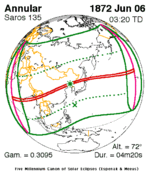 Annular |
0.3095 | 140 | November 30, 1872 Hybrid |
−0.5081 | |
| 145 | May 26, 1873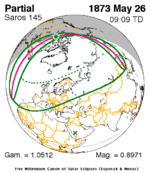 Partial |
1.0513 | 150 | November 20, 1873 Partial |
−1.2625 | |
Saros 150
[edit]This eclipse is a part of Saros series 150, repeating every 18 years, 11 days, and containing 71 events. The series started with a partial solar eclipse on August 24, 1729. It contains annular eclipses from April 22, 2126 through June 22, 2829. There are no hybrid or total eclipses in this set. The series ends at member 71 as a partial eclipse on September 29, 2991. Its eclipses are tabulated in three columns; every third eclipse in the same column is one exeligmos apart, so they all cast shadows over approximately the same parts of the Earth.
The longest duration of annularity will be produced by member 45 at 9 minutes, 58 seconds on December 19, 2522. All eclipses in this series occur at the Moon’s descending node of orbit.[4]
| Series members 5–27 occur between 1801 and 2200: | ||
|---|---|---|
| 5 | 6 | 7 |
 October 7, 1801 |
 October 19, 1819 |
 October 29, 1837 |
| 8 | 9 | 10 |
 November 9, 1855 |
 November 20, 1873 |
 December 1, 1891 |
| 11 | 12 | 13 |
 December 12, 1909 |
 December 24, 1927 |
 January 3, 1946 |
| 14 | 15 | 16 |
 January 14, 1964 |
 January 25, 1982 |
 February 5, 2000 |
| 17 | 18 | 19 |
 February 15, 2018 |
 February 27, 2036 |
 March 9, 2054 |
| 20 | 21 | 22 |
 March 19, 2072 |
 March 31, 2090 |
 April 11, 2108 |
| 23 | 24 | 25 |
 April 22, 2126 |
 May 3, 2144 |
 May 14, 2162 |
| 26 | 27 | |
 May 24, 2180 |
 June 4, 2198 | |
Metonic series
[edit]The metonic series repeats eclipses every 19 years (6939.69 days), lasting about 5 cycles. Eclipses occur in nearly the same calendar date. In addition, the octon subseries repeats 1/5 of that or every 3.8 years (1387.94 days). All eclipses in this table occur at the Moon's descending node.
| 22 eclipse events between September 8, 1801 and September 7, 1877 | ||||
|---|---|---|---|---|
| September 7–8 | June 26–27 | April 14–15 | January 31–February 1 | November 19–20 |
| 112 | 114 | 116 | 118 | 120 |
 September 8, 1801 |
 June 26, 1805 |
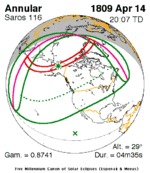 April 14, 1809 |
 February 1, 1813 |
 November 19, 1816 |
| 122 | 124 | 126 | 128 | 130 |
 September 7, 1820 |
 June 26, 1824 |
 April 14, 1828 |
 February 1, 1832 |
 November 20, 1835 |
| 132 | 134 | 136 | 138 | 140 |
 September 7, 1839 |
 June 27, 1843 |
 April 15, 1847 |
 February 1, 1851 |
 November 20, 1854 |
| 142 | 144 | 146 | 148 | 150 |
 September 7, 1858 |
 June 27, 1862 |
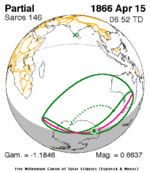 April 15, 1866 |
 January 31, 1870 |
 November 20, 1873 |
| 152 | ||||
 September 7, 1877 | ||||
Tritos series
[edit]This eclipse is a part of a tritos cycle, repeating at alternating nodes every 135 synodic months (≈ 3986.63 days, or 11 years minus 1 month). Their appearance and longitude are irregular due to a lack of synchronization with the anomalistic month (period of perigee), but groupings of 3 tritos cycles (≈ 33 years minus 3 months) come close (≈ 434.044 anomalistic months), so eclipses are similar in these groupings.
| Series members between 1801 and 1928 | ||||
|---|---|---|---|---|
 May 25, 1808 (Saros 144) |
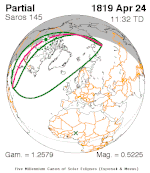 April 24, 1819 (Saros 145) |
 March 24, 1830 (Saros 146) |
 February 21, 1841 (Saros 147) |
 January 21, 1852 (Saros 148) |
 December 21, 1862 (Saros 149) |
 November 20, 1873 (Saros 150) |
 October 19, 1884 (Saros 151) |
 September 18, 1895 (Saros 152) |
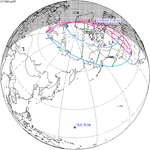 August 20, 1906 (Saros 153) |
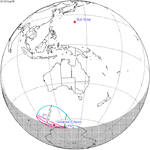 July 19, 1917 (Saros 154) |
 June 17, 1928 (Saros 155) | |||
Inex series
[edit]This eclipse is a part of the long period inex cycle, repeating at alternating nodes, every 358 synodic months (≈ 10,571.95 days, or 29 years minus 20 days). Their appearance and longitude are irregular due to a lack of synchronization with the anomalistic month (period of perigee). However, groupings of 3 inex cycles (≈ 87 years minus 2 months) comes close (≈ 1,151.02 anomalistic months), so eclipses are similar in these groupings.
| Series members between 1801 and 2200 | ||
|---|---|---|
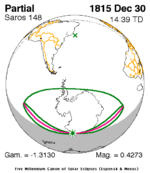 December 30, 1815 (Saros 148) |
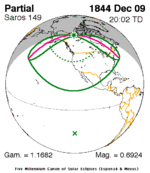 December 9, 1844 (Saros 149) |
 November 20, 1873 (Saros 150) |
 October 31, 1902 (Saros 151) |
 October 11, 1931 (Saros 152) |
 September 20, 1960 (Saros 153) |
 August 31, 1989 (Saros 154) |
 August 11, 2018 (Saros 155) |
 July 22, 2047 (Saros 156) |
 July 1, 2076 (Saros 157) |
 June 12, 2105 (Saros 158) |
 May 23, 2134 (Saros 159) |
 April 12, 2192 (Saros 161) |
||
See also
[edit]References
[edit]- ^ a b "Solar eclipse of November 20, 1873". NASA. Retrieved March 22, 2017.
- ^ "Partial Solar Eclipse of 1873 Nov 20". EclipseWise.com. Retrieved 2 September 2024.
- ^ van Gent, R.H. "Solar- and Lunar-Eclipse Predictions from Antiquity to the Present". A Catalogue of Eclipse Cycles. Utrecht University. Retrieved 6 October 2018.
- ^ "NASA - Catalog of Solar Eclipses of Saros 150". eclipse.gsfc.nasa.gov.




